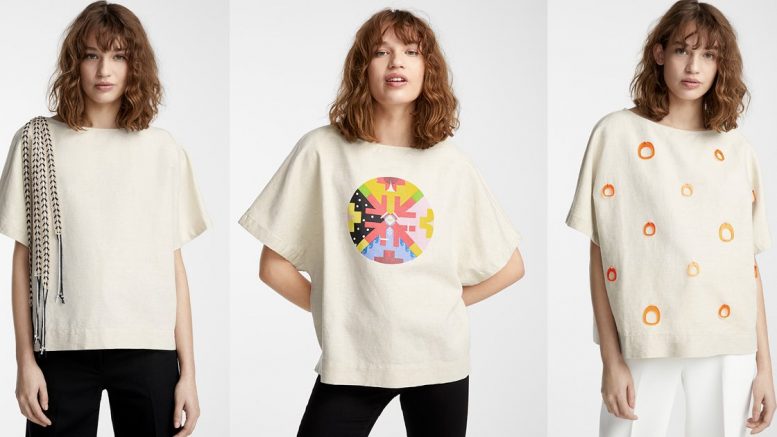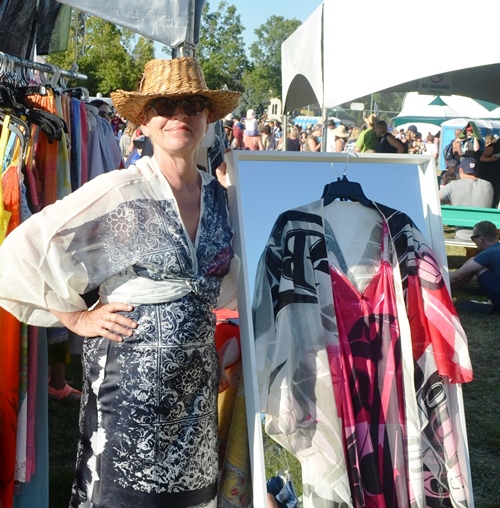By Laura Mushumanski
(ANNews) – Having the vision to present the most progressive, distinct and exceptional fashion, textiles and craft by Indigenous artists at the intersection of art, fashion and culture is what provoked Indigenous Fashion Week Toronto to collaborate with Edito PAR SIMONS to create a limited edition capsule collection.
The limited collection features 8 Indingeous artists from communities across Turtle Island. The garments themselves are made from organic cotton and linen, and are given to the artists as a blank canvas, allowing them to create one-of-a-kind collection pieces.
Each of the eight Indigenous artists had four different articles of clothing to work with; a boxy blouse, loose pants, cinch dress, and a shift dress. The collection showcases 30 unique garments of craftsmanship from each artist, including printed graphics, embroidery, natural dye, appliqué and beadwork.
The Indigenous led team at Indigenous Fashion Week Toronto commits to the leadership work in the dissemination and exportation of Indigenous-made works for the advancement and empowerment of Indigenous artists and designers, connecting them and their work to Canadian and international audiences, festivals, buyers, retailers, curators and institutes.
Artist Tania Larsson, uses red ochre dye from Turtle Island’s Northwest Territories representing a part of her culture, the Gwich’in culture. Larsson creates her unique style by incorporating land-based materials leather, fur, and bone into her art creations.
The mother-daughter duo Cheryl and Carissa Copenace of Injunuity Design Studio feature their Anishinaabe floral designs into their one-of-a-kind garments. The iskwewak use modern appliqué and traditional beadwork patterns that reflect the strength and resilience of their Anishinaabe culture.
Métis Manitoba designer, Evan Ducharme creativity focuses on images of contemporary Indigeneity, reclaiming of Indigenous sexualities, while committing to environmentally conscious practices. In the IFWTO + Edito PAR SIMONS collection, Ducharme’s garments consist of contemporary interpretations of formline art and Métis weaving,
Niio Perkins, shares stories of her people through her delicate Haudenosaunee beadwork designs. Perkins honors the unique gifts passed down through generations of Haudenosaunee (People of the Longhouse), and forging a legacy of cultural expression through design.
Jordan Bennett incorporates various mediums into his works that inspired by his interactions with Mi’kmaq porcupine quill designs, baskets, beadwork, clothing, and petroglyphs. Bennett reimagines Mi’kmaq quillwork into his digital graphics— a way for Bennett to showcase his love for his culture.
Warren Steven Scott braids together the Western concept of luxury fashion with his Nlaka’pamux ancestral worldview on ethics, craft, and aesthetic sensibility. Scott’s unique flair on design pictures combines a modern image of fashion through an Indigenous lens.
Tracy Toulouse features Ojibway Woodland storytelling motifs in her contemporary designs using appliqué, beads, quills, antlers, bone, fur, and ribbon work. Toulouse reinforces the Indigenous spirit and its connection to the land into each of her on-of-a-kind designs.
The Anishnaabe-French designer, Caroline Monnet traces her ancestral roots to her own contemporary way to describe the dynamic and ever-evolving history of the Anishnaabe and French. Monnet’s Indigenous work incorporates her own identity and bicultural living in creating her culture’s visual language.
The IFWTO + EDITO limited edition capsule collection can be found both in store and online at www.simons.ca.
Laura Mushumansli is a Local Journalism Initiative reporter.





Be the first to comment on "Indigenous artists represent culture In mainstream fashion"